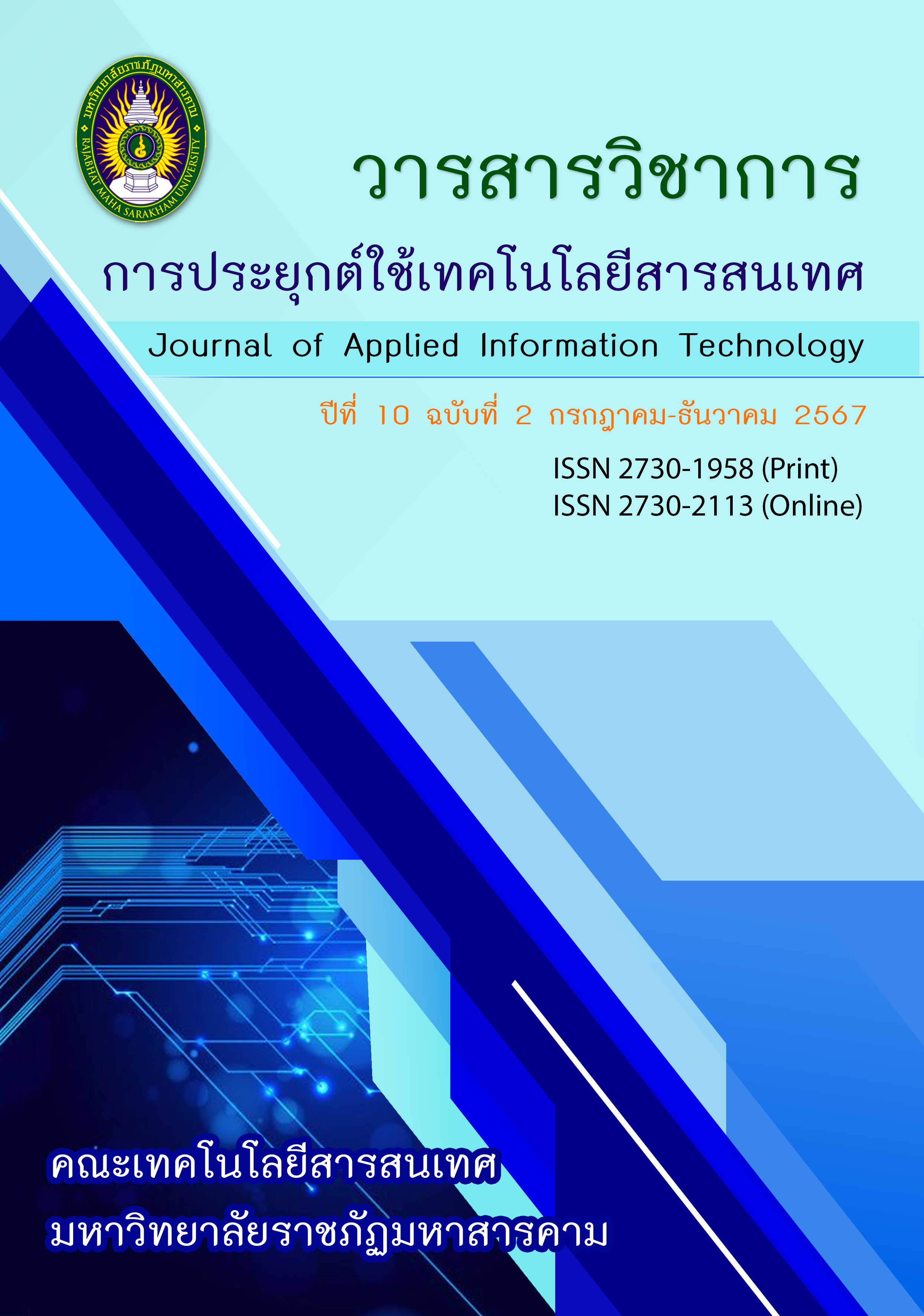การยอมรับเทคโนโลยีการจับการเคลื่อนไหวแบบปัญญาประดิษฐ์ในการผลิตแอนิเมชัน Acceptance of Artificial Intelligence Motion Capture Technology in Animation Production
Main Article Content
บทคัดย่อ
การวิจัยนี้มีวัตถุประสงค์เพื่อศึกษาและประเมินผลการยอมรับการใช้งานการจับการเคลื่อนไหวแบบปัญญาประดิษฐ์ในกระบวนการผลิตแอนิเมชัน โดยการสัมภาษณ์ผู้เชี่ยวชาญในภาคการผลิตแอนิเมชันและประเมินการยอมรับเทคโนโลยีด้วยแบบสอบถามนิสิตที่เรียนเรียนวิชาการจับการเคลื่อนไหว มหาวิทยาลัยมหาสารคาม จำนวน 83 คน ผลการวิจัยพบว่า (1) ผู้เชี่ยวชาญส่วนใหญ่มีความเห็นตรงกันว่า การจับการเคลื่อนไหวแบบปัญญาประดิษฐ์มีประโยชน์ ใช้งานง่าย และมีศักยภาพปฏิวัติวงการแอนิเมชันและเกมโดยเชื่อว่าจะกลายเป็นมาตรฐานอุตสาหกรรมในอนาคต (2) การยอมรับเทคโนโลยีจับการเคลื่อนไหวแบบปัญญาประดิษฐ์ของนิสิต 4 ปัจจัย พบว่า การรับรู้ประโยชน์อยู่ในระดับมาก ( ) การรับรู้ความง่ายในการใช้งานอยู่ในระดับมาก ( ) พฤติกรรมความตั้งใจในการใช้งานอยู่ในระดับมาก ( ) และการใช้งานจริงของระบบอยู่ในระดับมาก ( ) และทั้ง 4 ปัจจัย มีความสัมพันธ์เชิงบวกในระดับสูงอย่างมีนัยสำคัญทางสถิติที่ 0.05 ผลการวิจัยนี้แสดงให้เห็นว่า เทคโนโลยีการจับการเคลื่อนไหวแบบปัญญาประดิษฐ์เป็นเครื่องมือที่สนับสนุนภาคการผลิตแอนิเมชันในด้านการลดต้นทุน เพิ่มประสิทธิภาพ และสร้างการเคลื่อนไหวที่สมจริง และคาดว่าจะมีบทบาทมากยิ่งขึ้นในอุตสาหกรรมบันเทิงและภาพยนตร์ในอนาคต
Article Details
References
Deguzman, K. (2021). What is Mocap — The Science and Art Behind Motion Capture. Retrieved 20 September 2022 from https://www.studiobinder.com/blog/what-is-mocap-definition/
เบญนภา พัฒนาพิภัทร. (2564). การพัฒนาภาพเคลื่อนไหว 3 มิติ ด้วยเทคโนโลยีตรวจจับการเคลื่อนไหวสำหรับฝึกท่ามวยไทยพื้นฐาน. วารสารวิชาการนวัตกรรมสื่อสารสังคม, 9(2), 52-63.
Man-Woo, L., Hyun-Jong, K., & Soon-Gohn, K. (2006). A study about the problems and their solutions in the production process of 3D character animation using optical motion capture technology. Proceedings of the Korea Contents Association Conference, 831-835.
Baker, T. (2020). The History of Motion Capture Within The Entertainment Industry. Retrieved 3 April 2022 from https://www.theseus.fi/handle/10024/336908
นนทวรรษ ธงสิบสอง. (2555). การออกแบบและพัฒนาเครื่องโมชันแคปเจอร์อย่างง่าย เพื่อประยุกต์ใช้ในงานแอนิเมชัน 3 มิติ. การประชุมวิชาการมหาวิทยาลัยรังสิต ประจำปี 2555, 283.
Horrocks, N. (2021). NVIDIA Research: Generating Motion Capture Animation Without Hardware or Motion Data. Retrieved 7 March 2021 from https://developer.nvidia.com/blog/nvidia-ai-generating-motion-capture-animation-without-hardware-or-motion-data
Nakano, N., Sakura, T., Ueda, K., Omura, L., Kimura, A., Iino, Y., Fukashiro, S., & Yoshioka, S. (2020). Evaluation of 3D Markerless Motion Capture Accuracy Using OpenPose With Multiple Video Cameras. Front Sports Act Living, 2, 50. https://doi.org/10.3389/fspor.2020.00050
Theia Markerless, I. (2020). Why Markerless? Retrieved 10 March 2022 from https://www.theiamarkerless.ca/why-markerless/
He, K. (2020). XR for Animation: the Future is Less, Not More. Retrieved 31 Jully 2022 from https://www.gmw3.com/2020/12/xr-for-animation-the-future-is-less-not-more/
Takahashi, D. (2020). Move.ai enables AI motion capture without the hassle for video game production. Retrieved 31 Jully 2022 from https://venturebeat.com/2020/08/27/move-ai-enables-motion-capture-without-the-hassle-for-video-game-production/
Suwich Tirakoat. (2011). Optimized Motion Capture System for Full Body Human Motion Capturing Case Study of Educational Institution and Small Animation Production. https://doi.org/10.1109/DMDCM.2011.53
Fred D. Davis. (1989). Perceived Usefulness, Perceived Ease of Use, and User Acceptance of Information Technology. MIS Quarterly, 13(3), 319-340. https://doi.org/10.36863/mds.a.14027
Viswanath Venkatesh, & Fred D. Davis. (2000). A Theoretical Extension of the Technology Acceptance Model: Four Longitudinal Field Studies. Management Science, 46(2), 186-204. https://doi.org/10.1287/mnsc.46.2.186.11926
Mohammad Chuttur. (2009). Overview of the Technology Acceptance Model: Origins, Developments and Future Directions. Sprouts, 9(37).
Fred D Davis, Richard P. Bagozzi, & Pual R. Warshaw. (1989). User Acceptance of Computer Technology: a Comparison of Two Theoretical Models. Management Science, 982-1003.
บุญชม ศรีสะอาด. (2545). การวิจัยเบื้องต้น (ฉบับปรับปรุงใหม่) (พิมพ์ครั้งที่ 7.). สุวีริยาสาส์น. (กรุงเทพฯ)

